

Key data on learning and Innovation through ICT at school in Europe - Education policy. Students, Computers and Learning. Bok%3A978-3-319-19366-3.pdf?originUrl= The Paradox of Deeper Learning: The Unlearning Curve - Learning Deeply. Sharing: A Responsibility of the Modern Educator. In a past post blog I discussed the idea that every educator has a story and that they should share those stories: Educators are doing amazing things with their learners in spite of the standards-based and accountability-driven movements.
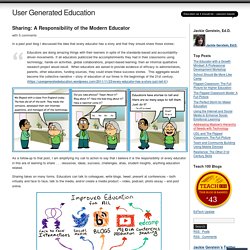
If all educators publicized the accomplishments they had in their classrooms using technology, hands-on activities, global collaborations, project-based learning; then an informal qualitative research project would result. When educators are asked to provide evidence of efficacy to administrators, parents, other educators, funding sources, they could share these success stories. This aggregate would become the collective narrative – story of education of our times in the beginnings of the 21st century.
Sharing takes on many forms. On a personal level, sharing assists the educator in becoming a better educator. The educator becomes a connected educator and through sharing, is an active participant and contributor to the connected educator movement. RSA Animate - Changing Education Paradigms. Benefits for Teachers using educational video to teach in a Classroom. Teachers Using subtitled video as a teaching aid in the classroom gain many benefits including greater student interest and improved reading and literacy skills.
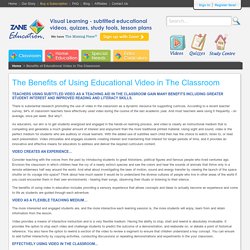
There is substantial research promoting the use of video in the classroom as a dynamic resource for supporting curricula. According to a recent teacher survey, 94% of classroom teachers have effectively used video during the course of the last academic year. Videowp.pdf. 70.%20Khot_S.A.%5B1%5D_final.pdf. Educational Technology For All: Multimedia Approach toTeaching Learning Process. Home. Roger Slack in his article ‘PEDACTICE - The Use of Multimedia in Schools’ which was published in September, 1999, comments that the growth of information and communication technology (ICT) in society is reflected in policies to encourage the use of ICT in education and the development of educational multimedia.

As the role of educational multimedia increases, it is increasingly important to have an idea of the potential it affords for teaching and learning. Multimedia, as per Pearson’s website, can be defined generically as any combination of two or more media such as sound, images, text, animation, and video. For educational technology purposes, multimedia refers to computer-based systems that use associative linkages to allow users to navigate and retrieve information stored in a combination of text, sounds, graphics, video, and other media. Exclusive survey: Parents weigh in on the digital classroom. For the last year, Marketplace's LearningCurve team has been looking at the impact of technology on education.

We've talked to students, teachers and ed-tech companies about the digital revolution taking hold in classrooms across the country. We've explored the promise of individualized learning and the peril of student data-mining. We've delved into the economics of the corporate arms race to outfit the nation’s classrooms, and student interactions with devices and software in lockup. Now we turn our attention to parents, many of whom have spent the last year exploring the ins-and-outs of educational technology themselves, alongside their children. Learning theory: models, product and process. Photo by Antenna on Unsplash Contents: introduction · what do people think learning is?
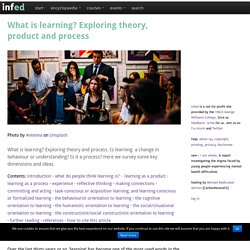
· learning as a product · learning as a process · experience · reflective thinking · making connections · committing and acting · task-conscious or acquisition learning, and learning-conscious or formalized learning · the behaviourist orientation to learning · the cognitive orientation to learning · the humanistic orientation to learning · the social/situational orientation to learning · the constructivist/social constructivist orientation to learning · further reading · references · how to cite this article. Curriculum Models: Product versus Process. 1.pdf. Yong Zhao: Outcome vs. Process: Different Incarnations of Personalization.
Focusing on outcomes to improve efficacy in education products. Focusing on outcomes to improve efficacy in education products 27Nov By OEC team Comments We were lucky enough to have a group session last week with Vaithegi Vasanthakumar, from the global efficacy team of the Office of the Chief Education Officer at Pearson, in preparation for this week’s residential in London.
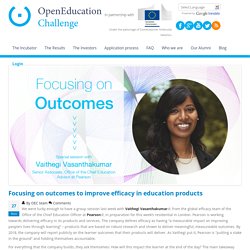
How Our Sense Of Touch Affects Everything We Do. We typically think of touch as a pleasant, but not particularly important part of life.
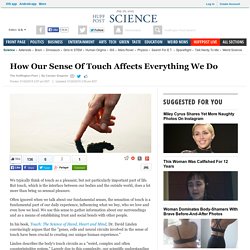
But touch, which is the interface between our bodies and the outside world, does a lot more than bring us sensual pleasure. Often ignored when we talk about our fundamental senses, the sensation of touch is a fundamental part of our daily experience, influencing what we buy, who we love and even how we heal. We use this sense to gather information about our surroundings and as a means of establishing trust and social bonds with other people.
In his book, Touch: The Science of Hand, Heart and Mind, Dr. David Linden convincingly argues that the "genes, cells and neural circuits involved in the sense of touch have been crucial to creating our unique human experience. " Linden describes the body's touch circuits as a "weird, complex and often counterintuitive system. " Recently, Linden and other scientists have begun to demystify the influence of touch on our lives. Reprogramming the Mind [The Human Condition] You Are What You Touch: How Tool Use Changes the Brain's Representations of the Body. All our experience of the world, and ability to act on it, are channelled through our body.
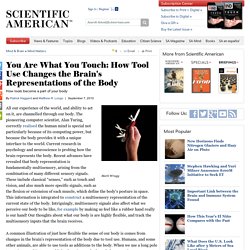
The pioneering computer scientist, Alan Turing, correctly realised the human mind is special not particularly because of its computing power, but because the body provides it with a unique interface to the world. Current research in psychology and neuroscience is probing how the brain represents the body. Tablets, touchscreens, and touchpads: How varying touch interfaces trigger psychological ownership and endowment. Abstract As mouse-driven desktop computers give way to touchpad laptops and touchscreen tablets, the role of touch in online consumer behavior has become increasingly important.

This work presents initial explorations into the effects of varying touch-based interfaces on consumers, and argues that research into the interfaces used to access content can be as important as research into the content itself. Psychology - Do touch screens have a harmful psychological effect on people? Communicating Through Touch. Editor’s note: David Rose is the CEO at Ditto Labs, an MIT Media Lab researcher and the author of Enchanted Objects.
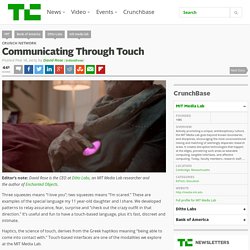
Three squeezes means “I love you”; two squeezes means “I’m scared.” These are examples of the special language my 11 year-old daughter and I share. We developed patterns to relay assurance, fear, surprise and “check out the crazy outfit in that direction.” It’s useful and fun to have a touch-based language, plus it’s fast, discreet and intimate. Transforming_edu_wp. Addio alla tastiera ecco la touch generation - Tecnologia. Bok%3A978-3-319-04093-6.pdf?originUrl= Digital Agenda for Europe. Index. Fate attenzione all'iPad.
Siamo tutti affetti dalla sindrome da eccesso di informazione, e non lo sappiamo. Si chiama “sindrome da eccesso di informazioni” o “sovraccarico cognitivo”, ma suona meglio in inglese (information overload): si verifica quando si ricevono troppe informazioni (il web contribuisce) per sceglierne una specifica sulla quale focalizzare l'attenzione e riuscire a immagazzinarla. La subiamo tutti i giorni e non lo sappiamo neanche, ma basta un esempio pratico. Lunedì 26 ottobre nella mia casella di posta sono arrivate: cinque newsletter (Travel Quotidiano, Guida Viaggi No Stop, l’agenzia di viaggi, TTG, Master Viaggi) con rispettivamente 21 + 49 + 15 + 27 + 34 notizie pubblicate, 146 in totale; 5 newsletter promozionali (TTG per il Costa Rica, l’agenzia di viaggi per Air France).
Totale, 150 notizie. SINDROME DA ECCESSO DI INFORMAZIONI PER IL CERVELLO ANZIANO Neurologia in pi� decine di articoli sull'argomento. Il Sovraccarico Informativo danneggia la capacità d'attenzione - Pensiero Critico. La sindrome da eccesso di informazioni. La necessità e il coraggio di proporre un’informazione focalizzata e coerente con un’identità editoriale. Interattivo - ilSole24ORE. Nomofobia, psichiatra: “La dipendenza da smartphone fa perdere controllo realtà” Nomofobia: il cellulare tra dipendenza e attacchi di panico. One to one computing (education) In the context of education, one-to-one computing (sometimes abbreviated as "1:1") refers to academic institutions, such as schools or colleges, issuing each enrolled student an electronic device in order to access the Internet, digital course materials and digital textbooks.
The concept has been actively explored and sporadically implemented since the late 1990s.[1] One-to-one computing is frequently contrasted with a policy of "bring your own device" (BYOD), which encourages or requires students to use their own laptops, smartphones or other electronic devices in class. One-to-one computing offers the benefits of equal access, standardization, easy upgrades, simple networking and the ability to monitor student progress and online behavior. How to Roll Out a 1:1 iPad Program. When The Westside School decided to grow its established primary school into a leading middle school program, parents, teachers, students and administrators mapped out an integrated project-based learning environment designed to engage and challenge all participants.
The planning team made a list of skills and tools that would support learning, and decided on a 1:1 iPad program to support their vision. I was brought on as technology coordinator to plan and support the curricular and technical deployment for the start of the 2011-12 school year. After a year or two of early adopter experimentation with education-based iPad deployments, a collaboration of IT departments, edTech consultants and third party vendors pieced together a best practice scenario for iOS management.
Eun. Il fallimento della scuola 2.0. Introduzione. How to Roll Out a 1:1 iPad Program. Why Schools Must Move Beyond One-to-One Computing. Perhaps it was the driving rain and the dark grey clouds of an approaching storm that contributed to the superintendent’s choice of words. He had spent the past month reviewing one-to-one computing programs in various school districts as he tried to decide whether his own district should commit to the enormous expense of a one-to-one program at a time of declining resources. His conclusion from his visits did not leave much room for interpretation. “Horrible, horrible, horrible implementation from every program I visited,” he said.
“All of them were about the stuff, with a total lack of vision.” His research convinced him not to move forward with one-to-one computing. One to one computing (education) Allegato_circolare5158_2015.pdf. iPad a Solid Education Tool, Study Reports. More and more schools are jumping on the digital bandwagon and adopting iPads for daily use in the classroom. Apple’s education-related announcements yesterday will no doubt bolster the trend, making faculty tools and student textbooks more engaging and accessible. But today another data point emerged, demonstrating that the iPad can be a valuable asset in education.
In a partnership with Apple, textbook publishers Houghton Mifflin Harcourt performed a pilot study using an iPad text for Algebra 1 courses, and found that 20 percent more students (78 percent compared to 59 percent) scored ‘Proficient’ or ‘Advanced’ in subject comprehension when using tablets rather than paper textbook counterparts. The study was conducted at a Riverside, California, middle school from Spring 2010 to Spring 2011 using HMH’s Fuse: Algebra I app. iPad a Solid Education Tool, Study Reports. Mobile and interactive media use by young children: The good, the bad and the unknown. iPad_Evaluation_Sydney_Region. Do Tablets in the Classroom Really Help Children Learn? Impact of lecturing with the tablet PC on students of different learning styles.
Research says iPads and smartphones may damage toddlers' brains. Tablets Present Benefits and Risks for At-Home Learning. Impact of lecturing with the tablet PC on students of different learning styles - ResearchGate. Serge Tisseron. Bambini e tablet: effetti cognitivi sulla generazione Touch. Tablet in classe, il racconto di un insuccesso. Generazione touch e apprendimento. Grazie mille Tablet! "Tablet e smartphone ritardano apprendimento nei più piccoli" New Padagogy Wheel Helps You Integrate Technology Using SAMR Model.
Bambini e tablet: se l'uso è eccessivo i genitori a Taiwan vengono multati. What Does a Tablet Do to the Child’s Mind? Experts talk about the risks of letting kids use technology. Are iPads and tablets bad for young children? Do Tablets and Smartphones Pose a Danger to Children? Tablets Present Benefits and Risks for At-Home Learning. Potenziamento cognitivo, la realtà del cervello aumentato. Studio Usa: Bambini e tablet, a rischio lo sviluppo emotivo e cognitivo. 20Effettidigitale.pdf. Bambini e tablet: effetti cognitivi sulla generazione Touch.